Introduction
Physical therapy in Pittsburgh for Pain Care
This article is for educational purposes only. GPPT does not offer this service.
 Radiofrequency ablation is a treatment where radio waves are used to create heat and destroy a part of a nerve. This technique is most commonly used to treat pain that is originating in the facet joints of the spine. The procedure is used to destroy the end of the small nerves that provide sensation to the facet joints. Once the nerve is destroyed, you should no longer feel the pain from the worn out, painful facet joints. This procedure is also sometimes called a RFA (which is short for radiofrequency ablation), a rhizotomy, or a neurotomy.
Radiofrequency ablation is a treatment where radio waves are used to create heat and destroy a part of a nerve. This technique is most commonly used to treat pain that is originating in the facet joints of the spine. The procedure is used to destroy the end of the small nerves that provide sensation to the facet joints. Once the nerve is destroyed, you should no longer feel the pain from the worn out, painful facet joints. This procedure is also sometimes called a RFA (which is short for radiofrequency ablation), a rhizotomy, or a neurotomy.
This guide will help you understand:
- What parts of the spine are involved
- What the surgeon is trying to achieve
- What happens during the procedure
- What the possible complications are
- What role Physical Therapy provides
Anatomy
What parts make up the spine?
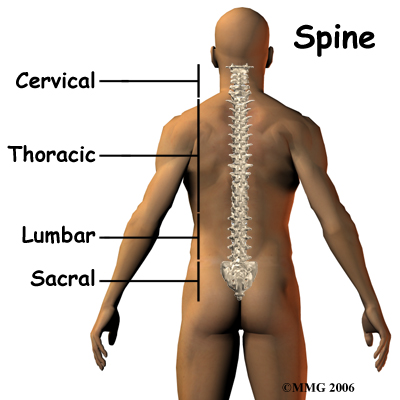 The spine is made up of 24 bones called vertebrae that stack on top of one another. Each vertebra has a ring of bone that encases and protects the spinal cord. When the vertebrae are stacked one on top of the other, these rings of bone create a hollow tube called the spinal canal. The spinal cord runs through the spinal canal from the brain to the lower spine. Between the vertebrae are intervertebral discs. The intervertebral discs cushion the spine and make it flexible. There are also two facet joints between each vertebra of the spine. The facet joints are located on the back of the spinal column in the lumbar and thoracic spine. In the neck, or cervical spine, they are located more to the side of the vertebra.
The spine is made up of 24 bones called vertebrae that stack on top of one another. Each vertebra has a ring of bone that encases and protects the spinal cord. When the vertebrae are stacked one on top of the other, these rings of bone create a hollow tube called the spinal canal. The spinal cord runs through the spinal canal from the brain to the lower spine. Between the vertebrae are intervertebral discs. The intervertebral discs cushion the spine and make it flexible. There are also two facet joints between each vertebra of the spine. The facet joints are located on the back of the spinal column in the lumbar and thoracic spine. In the neck, or cervical spine, they are located more to the side of the vertebra.
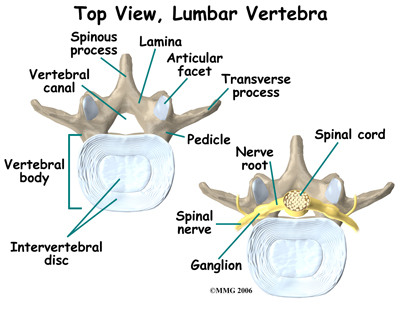
A facet joint is a small, bony knob that extends out from the vertebral body. Where these knobs meet, they form a joint that connects the two vertebrae; the one above and the one below. The surfaces of the facet joints are covered by articular cartilage. Articular cartilage is a smooth, rubbery material that covers the surface of all synovial joints. It allows the bone ends to move against each other smoothly without friction. A joint capsule surrounds each joint. The joint capsule is made up of the ligaments and connective tissues that help hold the joint together. The joint capsule forms a watertight sac that contains the joint fluid. The facet joints allow freedom of movement as you bend forward and back.
Like all joints, the facet joints can wear out, or ‘degenerate’ in medical terms. This condition is sometimes called degenerative arthritis or osteoarthritis. When this occurs in the facet joints it can cause neck and back pain. When the facet joints of the cervical spine are affected the pain can radiate into the upper back and shoulder area. When the facet joints of the lumbar spine are affected, the pain may radiate into the buttocks and back of the thigh.
Small nerves called the medial branch nerves provide sensation to each facet joint. These nerves carry the pain signals from the facet joint to the spinal cord. The signals eventually reach the brain where you feel the sensation of pain.
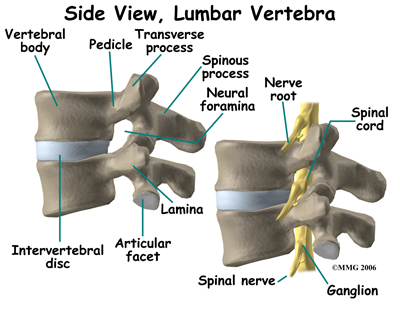
Rationale
What do surgeons hope to achieve with this procedure?
There are several structures in the spine that can be a source of pain. One of the most common sources is the facet joint. As these joints degenerate and develop osteoarthritis they become painful. The pain from facet joint arthritis may come and go depending on activity.
The goal of radiofrequency ablation is to destroy the small nerves that carry the pain signal from the joint to the spinal cord. The aim of this is to reduce your pain, allow you to do more activity, and enable you to reduce your pain medications.
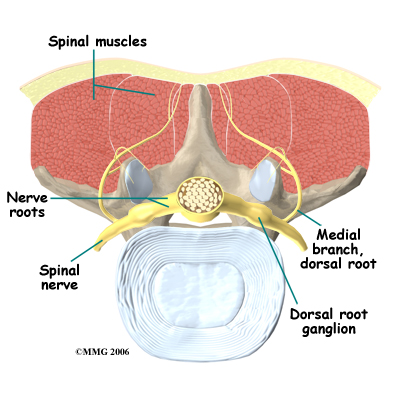
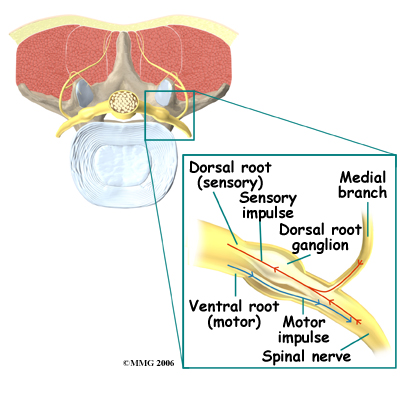
Radiofrequency ablation is usually done only after you have had a successful facet joint injection. Your doctor will perform a facet joint injection to try and determine if the facet joints are the cause of your back pain. The injection may only reduce your pain temporarily, maybe only for a few hours. Once your doctor is sure that it is the facet joint causing your pain, radiofrequency ablation is done to reduce your pain for a longer period of time. Radiofrequency ablation is not a permanent fix, but it lasts much longer than a facet joint block.
Preparation
How should I prepare for the surgery?
To prepare for the procedure your doctor may tell you to remain "NPO" for a certain amount of time before the procedure. This means that you should not eat or drink anything for the specified amount of time before your procedure. This means no water, no coffee, and no tea. Nothing at all should be ingested. You may receive special instructions to take your usual medications with a small amount of water. Check with your doctor if you are unsure of what to do.
You may be instructed to discontinue certain medications that affect the clotting of your blood several days before the injection. As long as your doctor determines it is safe to discontinue these medications for a short period in order to have the procedure, doing so reduces the risk of excessive bleeding during and after the injection. These medications may include the common Non-Steroidal Anti-Inflammatory Drugs (NSAIDs) such as aspirin, ibuprofen, and naproxen, as well as blood thinning drugs such as Warfarin and many other medications that are commonly used to treat arthritis.
You may need to arrange to have transportation both to and from the location where you will undergo the procedure. Wear loose fitting clothing that is easy to take off and put on. You may wish to take a shower the morning of the procedure, using a bactericidal soap to reduce chances of infection. Do not wear jewelry or any type of scented oils or lotions.
Procedure
What happens during the procedure?
When you are ready to have the procedure, you will be taken into the procedure area and an IV will be started. The IV allows the nurse or doctor to give you any medications that may be needed during the procedure. The IV is for your safety because it allows a very rapid response time if you have a problem during the procedure, such as an allergic reaction to any of the medications injected. If you are in pain or anxious about the procedure, you may also be given medications through the IV for sedation.
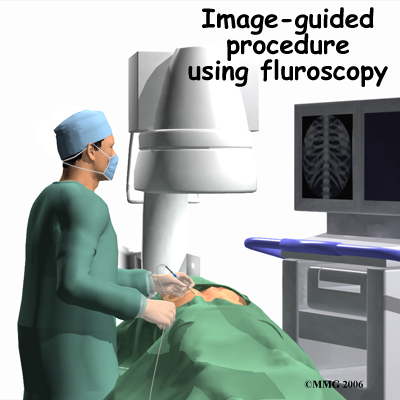
You will be awake for the procedure to help the doctor with correct placement of the electrode used for radiofrequency ablation. You will not be given a general anesthetic. The area to be treated will be cleaned and then numbed with a local anesthetic.
Radiofrequency ablation is done with the help of fluoroscopic guidance. The fluoroscope is an x-ray machine that allows the doctor to actually see an x-ray image while doing the procedure. This allows the doctor to watch where the needle electrode goes as it is inserted. This makes placing the electrode much safer and much more accurate. In performing radiofrequency ablation, your doctor inserts a needle electrode near the facet joint so that the tip of the needle is very near the medial branch nerve that travels to the facet joint. Once your doctor is sure that the tip of the needle is in the right place, the tip of the needle is heated to cauterize and destroy the nerve. Once the nerves carrying the sensation from the painful joints are destroyed, your pain should be reduced.
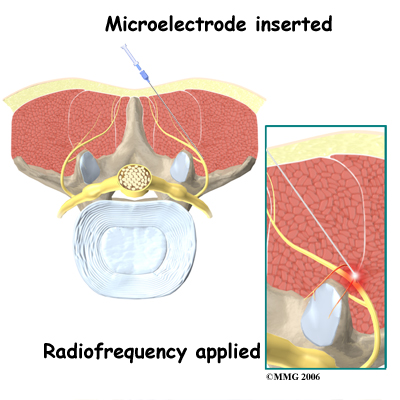
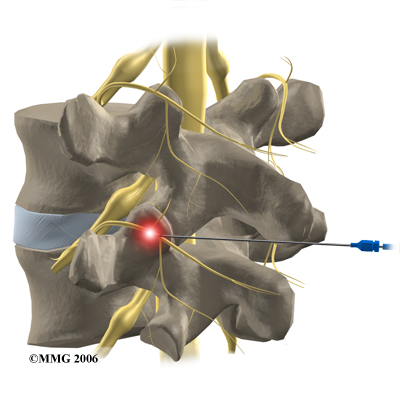
After the procedure, you will be taken to a recovery area. The nurses will monitor you to be sure you do not have an allergic reaction to any of the medications used. You will be allowed to leave once you are stable.
After Care
What should I expect after the procedure?
You will be able to go home soon after the procedure, probably within one hour. If all went as planned, you probably won't have any restrictions on activity or diet. Immediately following the procedure, you may have some relief of pain from the numbing medication used during the procedure. You may be restricted from driving or doing any physical activity for 24 hours.
You may experience an increase in pain for the first several days following the procedure simply due to the invasive nature of the procedure itself. Additional pain medications may be necessary to make you comfortable. If these medications include narcotics, you will need to watch for constipation. If constipation should occur you can use a laxative, which is available over-the-counter. You can naturally combat constipation by drinking lots of fluids and eating foods with plenty of fiber.
You may also note some swelling and bruising where the needle was inserted. Using a cold or hot pack may ease the discomfort.
The degree of pain relief from an ablation varies from person to person. You may continue to see a decrease in your pain for up to three weeks and you may see an overall 50 percent or greater relief of pain. The effects of the ablation can last from 6 to 12 months, sometimes even longer. The nerves will grow back eventually and your pain will likely return. When this occurs, the procedure may be repeated.
Most doctors will arrange a follow-up appointment, or phone consult, within one or two weeks after the procedure to see how you are doing and to determine what effect the procedure has had on your symptoms.
Post-Surgical Rehabilitation
Physical therapy after radiofrequency ablation can generally begin immediately unless your doctor recommends otherwise.
As indicated above, the radiofrequency ablation is done with the goal of trying to reduce your pain. The pain in your neck or back, however, can be caused from a variety of different reasons therefore the rehabilitation treatment you receive at Greater Pittsburgh Physical Therapy & Sports Medicine will vary according to what structures are involved in causing your pain. Your treatment will also be designed to suit your specific individual rehabilitation needs.
Some aspects of general rehabilitation, however, will be similar for all patients who have undergone an ablation. It is important to use any window of time where your pain has decreased or has been eliminated as a result of the ablation to engage in rehabilitation. Often this pain-free or pain-reduced time allows you a window where you can more effectively rehabilitate your spine, improve your overall movements, and make positive gains in your condition.
During your first few treatments your therapist will initially work to relieve any residual pain that you may still have after the ablation, or as a result of the procedure itself. They may use heat, ice, or electrical modalities such as ultrasound or interferential current to help decrease your pain. Depending on where your original injury and pain were they may also massage around your neck, shoulders, back, buttocks, and hip areas to provide relief by relaxing tight muscles that are pulling on the joints of the spine.
In order to know how best to treat your individual problem, your physical therapist will do a full assessment of your neck or back and will determine how well it is moving. They will also take note of any other symptoms you feel such as tingling or numbness and will assess for any muscle weaknesses you may have. If it is determined that any part of your spine motion is limited, your therapist will work to encourage more movement. In order to do this they may use joint mobilizations or manipulations, perform passive stretching, or massage any tight muscles related to the area. Stretches and strengthening exercises as part of a home program will also be prescribed as they can help you gain more motion in your own spine, improve the strength and endurance of the muscles that help to support your spine, and work to correct any muscle imbalances that may exist.
Maintaining a strong core muscle area is a crucial part of managing any pain in your neck and particularly in your back. Maintaining strong core muscles will allow you to maintain as active of a lifestyle as you can despite any chronic pain. Your physical therapist can teach you how to properly activate your core muscles and build up their strength and endurance. Even just simple exercises such as gently tightening the muscles of your deep abdominal area directly after your ablation will help to support your spine. If your therapist has deemed the joints in your spine to be relatively moving too much, then the core exercises prescribed are even more crucial. As you improve the activation, strength, and endurance of your core muscles, more advanced exercises will be prescribed in order to challenge the ability of these muscles and to ensure they can stabilize the spine during everyday functional activities.
Doing your prescribed exercises in a hydrotherapy pool after undergoing an ablation may be a useful option for you that you can discuss with your therapist. Depending on which part of your body is injured, often the warmth of the pool and the hydrostatic properties of the water can make range or motion, strengthening, and overall retraining of muscular control easier.
As with any injury or biomechanical dysfunction, maintaining one’s posture and alignment is very important. Your therapist will be strict in encouraging you to maintain proper posturing and alignment at all times. Maintaining good posture can significantly decrease the stress put through the spine and can also encourage your core muscles to work more efficiently. Any window of time that you have which is pain-free after your ablation can also be particularly useful in re-training your body to maintain proper alignment and develop functional movement patterns. By improving the endurance of the muscles that support your spine, you will be able to maintain your posture and alignment for longer periods of time, and lengthen the time frame between any flare-ups that may occur. In order to assist you with your posturing or to decrease any lingering pain your therapist may use tape on your back or neck in order to provide some feedback regarding the position of your spine as well as provide some external support.
Generally the treatment we provided for physical therapy for your spine after radiofrequency ablation can assist greatly in managing your pain but it should be remembered that this procedure may not be a cure for your chronic pain; they are only a part of your overall pain management plan. You will need to continue working long-term with your doctor, physical therapist, and any other health care professional involved in your pain management. You will also need to continue faithfully doing your rehabilitation home program in order to best manage your pain. If your pain has not been positively affected by the ablation, increases, or returns despite the ablation and regular physical therapy treatment, your therapist may ask you to return to see your surgeon in order to discuss the possibility of another ablation or other pain management options.
Complications
What might go wrong?
There are several complications that may occur during or after the ablation. Radiofrequency ablation is generally safe and unlikely to result in a complication, but no procedure is 100% foolproof. This document doesn't provide a complete list of the possible complications, but it does highlight some of the most common problems. As indicated, complications are uncommon, but you should know what to watch for if they occur.
Allergic Reaction
Like most procedures where medications are injected, there is always a risk of an allergic reaction. The medications that are commonly injected include lidocaine, bupivicaine, radiographic dye, and cortisone. Allergic reactions can be as simple as developing hives or a rash. They can also be life threatening and restrict breathing. Most allergic reactions will happen immediately while you are in the procedure room so fortunately help is available immediately. In addition, most reactions are treated and cause no permanent harm. You should alert your doctor if you have known allergies to any of medications ahead of the procedure.
Infection
Several types of infections are possible complications of radiofrequency ablation. Any time a needle is inserted through the skin, there is a possibility of infection. Before any invasive procedure is done, the skin is cleansed with a disinfectant and the health care provider doing the procedure uses what is called a sterile technique. This means that the instruments and the area where the skin is punctured remains untouched by anything that is not sterile. The doctor will also use sterile gloves and proper hand washing techniques to reduce the overall chance of an infection.
Infections can occur just underneath the skin, in a muscle, or in the facet joint. Signs of an infection are increasing redness, swelling, pain, and a fever. Almost all infections will need to be treated with antibiotics. If an abscess forms, then a surgical procedure may be necessary to drain the pus in the abscess. Antibiotics will also be necessary to treat the infection.
Nerve Damage
Many pain procedures are done close to nerves. Radiofrequency ablation is one of the safest spinal procedures because the needle electrode is usually not near the larger spinal nerves, but the needle electrode used to do the injection may accidentally hit a nerve while being positioned. Unfortunately this can cause damage to the nerve and result in increased pain. Numbness and weakness may also result. Nerves that have been punctured with a needle will usually recover and do not require any additional surgical procedures.
Neuritis
Neuritis is an inflammation of the nerve that causes pain and tenderness in the back. It may last from three to six weeks. This can occur in 10 to 15 percent of patients. Neuritis usually goes away by itself. If it does not, your doctor may suggest injecting a local anesthetic along with a steroid medication around the nerve. This may reduce the inflammation and ease your pain.
Increased Pain
Not all radiofrequency ablation procedures work as expected. Even though a test block was beneficial, some patients have no pain relief from the procedure. Sometimes, the procedure can actually cause more pain. Increased pain that begins several days after the injection may also be a sign of infection so you should alert your doctor if this occurs.
Portions of this document copyright MMG, LLC
 Radiofrequency ablation is a treatment where radio waves are used to create heat and destroy a part of a nerve. This technique is most commonly used to treat pain that is originating in the facet joints of the spine. The procedure is used to destroy the end of the small nerves that provide sensation to the facet joints. Once the nerve is destroyed, you should no longer feel the pain from the worn out, painful facet joints. This procedure is also sometimes called a RFA (which is short for radiofrequency ablation), a rhizotomy, or a neurotomy.
Radiofrequency ablation is a treatment where radio waves are used to create heat and destroy a part of a nerve. This technique is most commonly used to treat pain that is originating in the facet joints of the spine. The procedure is used to destroy the end of the small nerves that provide sensation to the facet joints. Once the nerve is destroyed, you should no longer feel the pain from the worn out, painful facet joints. This procedure is also sometimes called a RFA (which is short for radiofrequency ablation), a rhizotomy, or a neurotomy.







 The spine is made up of 24 bones called vertebrae that stack on top of one another. Each vertebra has a ring of bone that encases and protects the spinal cord. When the vertebrae are stacked one on top of the other, these rings of bone create a hollow tube called the spinal canal. The spinal cord runs through the spinal canal from the brain to the lower spine. Between the vertebrae are intervertebral discs. The intervertebral discs cushion the spine and make it flexible. There are also two facet joints between each vertebra of the spine. The facet joints are located on the back of the spinal column in the lumbar and thoracic spine. In the neck, or cervical spine, they are located more to the side of the vertebra.
The spine is made up of 24 bones called vertebrae that stack on top of one another. Each vertebra has a ring of bone that encases and protects the spinal cord. When the vertebrae are stacked one on top of the other, these rings of bone create a hollow tube called the spinal canal. The spinal cord runs through the spinal canal from the brain to the lower spine. Between the vertebrae are intervertebral discs. The intervertebral discs cushion the spine and make it flexible. There are also two facet joints between each vertebra of the spine. The facet joints are located on the back of the spinal column in the lumbar and thoracic spine. In the neck, or cervical spine, they are located more to the side of the vertebra.






